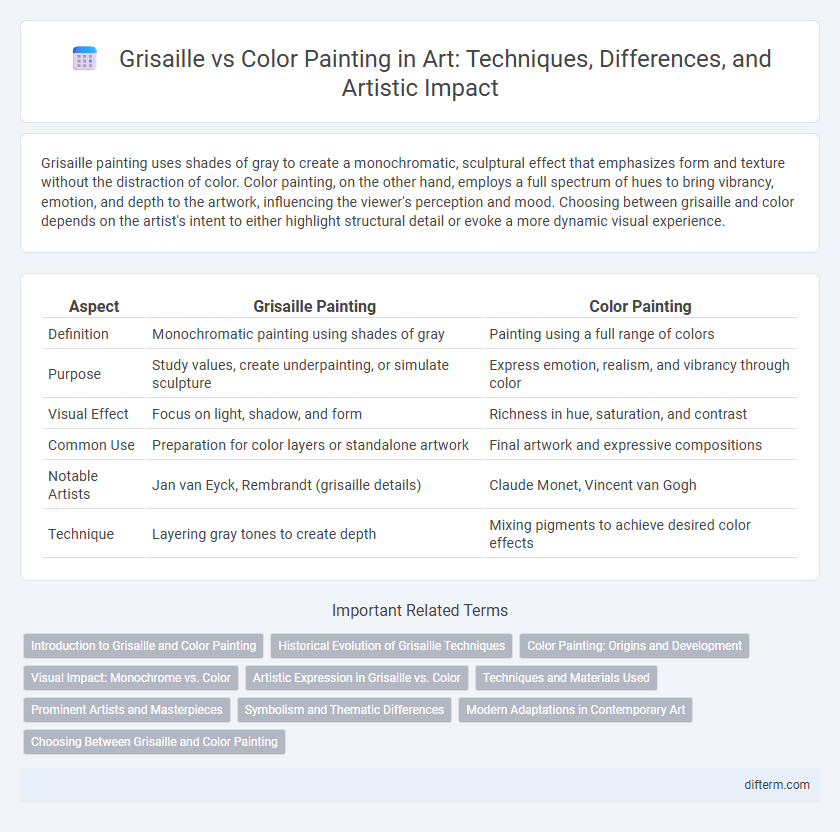Grisaille painting uses shades of gray to create a monochromatic, sculptural effect that emphasizes form and texture without the distraction of color. Color painting, on the other hand, employs a full spectrum of hues to bring vibrancy, emotion, and depth to the artwork, influencing the viewer's perception and mood. Choosing between grisaille and color depends on the artist's intent to either highlight structural detail or evoke a more dynamic visual experience.
Table of Comparison
| Aspect | Grisaille Painting | Color Painting |
|---|---|---|
| Definition | Monochromatic painting using shades of gray | Painting using a full range of colors |
| Purpose | Study values, create underpainting, or simulate sculpture | Express emotion, realism, and vibrancy through color |
| Visual Effect | Focus on light, shadow, and form | Richness in hue, saturation, and contrast |
| Common Use | Preparation for color layers or standalone artwork | Final artwork and expressive compositions |
| Notable Artists | Jan van Eyck, Rembrandt (grisaille details) | Claude Monet, Vincent van Gogh |
| Technique | Layering gray tones to create depth | Mixing pigments to achieve desired color effects |
Introduction to Grisaille and Color Painting
Grisaille is a monochromatic painting technique using varying shades of gray to create the illusion of sculpture or depth, often employed in underpainting or standalone works. Color painting utilizes a full spectrum of pigments to enhance visual realism, emotional impact, and narrative complexity in artworks. Both methods serve distinct artistic purposes, with grisaille emphasizing form and structure, while color painting highlights vibrancy and mood.
Historical Evolution of Grisaille Techniques
Grisaille techniques originated in the medieval period as a method to create monochromatic images that mimic sculptural reliefs, often used in illuminated manuscripts and stained glass windows. By the Renaissance, artists like Jan van Eyck and Albrecht Durer refined grisaille methods to add tonal depth and subtlety to underpaintings, enhancing the final color layers. The historical evolution of grisaille reflects its transition from a purely preparatory technique to an independent form of artistic expression valued for its emphasis on light, shadow, and form without color.
Color Painting: Origins and Development
Color painting traces its origins to early prehistoric cave art where natural pigments were applied to create vibrant depictions of animals and human figures. The development of color painting advanced significantly during the Renaissance, with innovations in pigment production and the introduction of oil paints enabling artists to achieve greater depth, realism, and emotional expression. By the Baroque period, color painting had evolved into a sophisticated technique that conveyed mood and narrative through contrast, hue, and saturation, setting it apart from the monochromatic grisailles used primarily for preparatory studies or decorative purposes.
Visual Impact: Monochrome vs. Color
Grisaille paintings create a striking visual impact through their monochrome palette, emphasizing form, texture, and light contrasts without the distraction of color. In contrast, color paintings engage viewers with a vibrant spectrum that evokes emotional responses and highlights realism or symbolic meanings. The choice between grisaille and color painting fundamentally shapes the artwork's mood, depth, and interpretative possibilities.
Artistic Expression in Grisaille vs. Color
Grisaille painting emphasizes tonal values and monochromatic shading to create depth and form, allowing artists to focus on composition and light without the distraction of color. Color painting introduces a broader emotional range through hues and saturation, adding complexity and vibrancy that can evoke mood and symbolism more directly. The choice between grisaille and color significantly influences the artistic narrative, with grisaille often serving as an underpainting or a study in value, while color engages the viewer on multiple sensory levels.
Techniques and Materials Used
Grisaille painting technique involves using shades of gray to create a monochromatic image that emphasizes form and volume through careful layering of acrylic or oil paints. Color painting utilizes a broader palette of pigments, often mixed with mediums like linseed oil or acrylic binders, to achieve vibrant hues and complex color interactions. Both methods require specific brushes and supports, with grisaille often serving as an underpainting base for subsequent color layers in traditional oil painting techniques.
Prominent Artists and Masterpieces
Grisaille painting, exemplified by Jan van Eyck's "Ghent Altarpiece" panels, uses shades of gray to simulate sculpture and emphasize form, while color painting, as seen in works by Claude Monet such as "Impression, Sunrise," exploits vibrant hues to convey emotion and atmosphere. Prominent artists like Diego Velazquez employed grisaille in preparatory studies, contrasting with color masters like Vincent van Gogh, whose "Starry Night" showcases expressive color palettes. The distinction between grisaille and color painting highlights differing artistic approaches, with grisaille focusing on tonal value and structure, and color painting prioritizing chromatic richness and visual impact.
Symbolism and Thematic Differences
Grisaille painting employs shades of gray to emphasize form, structure, and subtle gradations, often symbolizing purity, melancholy, or timelessness within the artwork's theme. In contrast, color painting uses vibrant hues to evoke emotions, highlight symbolic elements, and create dynamic narrative layers, reflecting themes like vitality, passion, or cultural significance. Thematic differences between these techniques stem from grisaille's restraint and focus on materiality, while color painting invites sensory richness and complex symbolic expression.
Modern Adaptations in Contemporary Art
Modern adaptations of grisaille in contemporary art emphasize its monochromatic precision to evoke depth and emotion without the distraction of color, often merging it with vibrant hues to create striking contrasts. Artists leverage grisaille's foundational tonal structure to experiment with layers of color transparency, enhancing visual complexity while maintaining classical techniques. This fusion challenges traditional boundaries, showcasing grisaille's enduring relevance and innovation in today's artistic practices.
Choosing Between Grisaille and Color Painting
Choosing between grisaille and color painting depends largely on the desired mood and artistic effect. Grisaille, a monochromatic technique using shades of gray, emphasizes form, light, and shadow, making it ideal for detailed studies or creating a dramatic, timeless atmosphere. Color painting offers a vibrant range of hues that convey emotion and realism, suitable for capturing lively scenes and enhancing visual storytelling.
grisaille vs color painting Infographic

 difterm.com
difterm.com